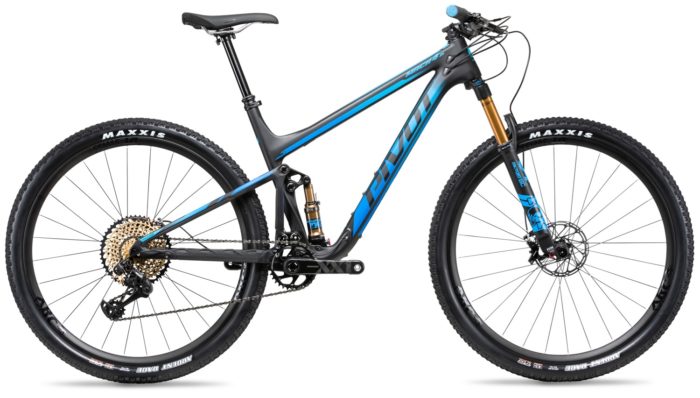Trek and Pivot have just released updates to their cross-country full-suspension bikes, and the trend towards longer travel, longer reach, slacker head angles and all-round more capable bikes doesn’t look to be slowing down.
We think this is another great step, with more companies building bikes that probably suit their world-class riders, but really do suit the rest of us as well. The ‘new school’ XC bikes tend to be stiffer and more confidence inspiring, making them better for tackling the more demanding courses in XC races, but also in the shorter stage races and even the longer stage races and marathons too. Of course, if your riding doesn’t demand slacker geometry, more travel and a dropper post that’s fine – there are always hardtails and a few entirely race focused bikes out there. But we love this shift!
The new Pivot Mach 4 SL
No one will deny that the last Pivot Mach 429 SL really didn’t do the SL part of its name much justice. Thanks to the DW-Link the bike rode really well, and had the frame stiffness and suspension platform to be a highly capable bike. But like most bikes, their good geometry from 5 years ago starts to look steep and short by current standards.
The reach has extended to 447mm in a large, with a 68.5 degree head angle when paired with a 100mm fork, or 67.5 degrees if matched with a 120mm fork – the Pivot Mach 4 SL is designed to handle both options. The seat angle is 74.5 degrees or 73.5 if you run the longer fork. This isn’t as steep as some bikes like the new Norco Revolver, and it does promote seated pedalling more. That’s not a bad thing for a marathon and stage race bike.
The frame weight starts at 1930g including shock, and the bike has been designed around integration with Fox Live Valve. Live Valve lets a computer take care of the choices about locking out or opening up. It’s a very expensive piece of specialised kit, and with pricing going to about $AUD15k for the top models, it’s something you’re unlikely to see a whole lot of on the trails. The DW-link is optimised for excellent pedalling so the Live Valve really is the cherry on the cake.
It is completely carbon fibre, and all sizes use a 29″ wheel. Even the XS frame can fit a full water bottle in the mainframe – and the XL can fit two. Otherwise it’s a single bottle bike (in terms of inside the mainframe).
Cables are routed internally via a port system, which should be easy and clean for people with different cockpit setups, like right to front, or for using SRAM AXS or who knows what. It’s clean, it’s easy to mix it up for personal choices.
With a significant weight drop and builds with a 100mm or 120mm fork, the new Pivot Mach 4 SL ticks a whole lot of boxes. Spec is online, and pricing is available via your local Pivot dealer. We’ll be keen to here Gordon W. Wadsworth’s opinion on his new ride later this year.
Trek’s new Top Fuel
The Trek Top Fuel has been a difficult bike to pass up since it’s redesign about 4.5 years ago. With 100mm front and back, dropper compatibility, low standover height, high quality frame and Boost wheel spacing since forever it really ticked a lot of boxes – although fitting a bottle larger than 600mL wasn’t easy unless you were on a big frame.
The main changes you will notice on the Top Fuel are a shift to 120mm forks and 115mm travel out the back. The MinoLink means you can switch between a 67.5 and 68 degree head angle for the low or high position, which also changes the reach, from about 470 to 475mm in a large. Chainstays are a standard 435mm, and the seat angle is pushed to 75 degrees, or 75.5 in the high position.
But there are some changes with the suspension, as the Full Floater design where the shock attaches to a lower link is gone, replaced by a fixed mount for lower weight and greater stiffness. The shock is inverted and sits lower in the frame, helping to get the centre of gravity lower as well.
Trek also bring some trail bike tech across, like the Straight Shot downtube with the Knock Block. Basically the downtube is straight, so there is a lock on the top tube to prevent frame damage. There are a couple of other changes, and it’s 29″ wheel sizes only, and 1x only as well. Which isn’t surprising. You can also fit 29×2.4″ tyres in, to really take advantage of modern wider rims.
Racers will be keen to see that a dual lock out via a left hand twist shift remains, which means you can have an under the bar dropper lever. A dropper post is standard on all models.
Where does this bike fit? Well with a stem that can be run 13 degrees up or down for 47mm of bar heigh adjustment, Trek are aiming to find a broad market. It looks ideal for those of us who want something a little more capable. Be it for an event like the Swiss Epic, BC Bike Race or the Breck Epic. Or just to actually have more fun on the trails – and fun is fast, especially when there isn’t much of a disadvantage in the efficiency. Trek hasn’t listed the weight of the frame or bike, but you can head into your local dealer and ask. Find our more on the Trek website.

